
The Dogo Argentino or Argentine Mastiff is a large, powerful, intelligent dog. Sounds like a great mix of traits for an excellent hunting partner, and he definitely is! Bred to be a hunting dog for large prey and also to be a loyal protective member of a family. The Argentine Mastiff is known for his courage and commitment to work. The Dogo Argentino is not a dog for the faint of heart, owners must know how to properly train this capable dog. As a hunting dog, he requires physical exercise and mental stimulation. With the right training and a firm loving home, the Argentine Mastiff can be an excellent hunter, a guard dog, as well as a companion.
![]()
![]()
![]()
![]()
![]()
![]()
![]()
![]()
![]()
![]()
Did You Know?
- The Argentine Mastiff has an exceptionally strong prey drive, making him an excellent hunter. Unlike other hunting dogs, the Argentine Mastiff has the courage to hunt wild boar and even Pumas. If you hunt large prey that can put up a fight, the Dogo Argentino is a breed to consider.
- Like many other intelligent dogs, the Dogo Argentino can be very headstrong and a challenge to train. Early, consistent socialization and training is a must. This is not a breed for first-time owners. As an owner, you must know how to firmly train him for a variety of situations.
- Dogo’s are chewers. They love to chew just about anything. If you don’t want them finding and creating their own chew toy, be sure to provide them with plenty of tough chew toys that are acceptable for them to chew on until they have chewed it to bits.
- Like many other dogs, he will be a better companion as he spends more time with his family. He likes to be outside but should not be chained up for long periods of time. This can lead to aggression and behavior problems. If he spends more time inside with his “pack” he will behave like a member of the family.
- Dogo Argentino’s are also trained to be police dogs, search and rescue dogs, service dogs, guides for the blind, and military dogs. Dogos also do very well at obedience competitions.
- Be aware that it is illegal to own a Dogo in certain countries without lawful authority. Some of those countries are Denmark, Iceland, Fiji, Ukraine, Australia, Singapore, and the United Kingdom. Though they have been bred to make them less aggressive, some countries still have them banned under “dangerous dog acts.”
Breed Characteristics
Adaptability

Adapts Well to Apartment Living: 4/5
Good for Novice Owners: 1/5
Tolerates Being Alone: 1/5
All-Around Friendliness

Affectionate with Family: 3/5
Dog-Friendly: 3/5
Friendly Toward Strangers: 2/5
Health Grooming

Amount of Shedding: 4/5
Easy to Groom: 4/5
General Health: 4/5
Trainability

Easy to Train: 3/5
Intelligence: 5/5
Tendency to Bark or Howl: 5/5
Exercise Needs

Energy Level: 5/5
Exercise Needs: 4/5
Potential for Playfulness: 4/5
 History
History
What happens when a 17-year-old dreams of a dog that can handle the rough terrain of Argentina as a loyal hunting partner? The Dogo Argentino is born. A young Antonio Nores Martinez desired a courageous, athletic, hunting partner that was also gentle and loyal to his family. He started with the now extinct Cordoba fighting dog. This dog was the base for a fearless and courageous dog that would have the ability to hunt wild boar and pumas. Cordobas were great hunters but extremely aggressive, hence why they were used for dog fights. Martinez crossbred 10 Cordobas with a Mastiff, Bulldog, Great Dane, Boxer, Bull Terrier, Great Pyrenees, Irish Wolfhound, Pointer, and Dogue de Bordeaux. He continued to use selective breeding to temper the dog to achieve the traits he desired to have and ended up with the perfect hunting partner and loyal family member. The breeds Martinez mixed into developing the Dogo were to increase height, accentuate scenting abilities, increase speed, strong hunting instinct and have a highly sociable nature.
Argentine hunters began using the Dogos as hunting companions, they were able to track wild boars for long distances and then hold them until the hunter arrived. Sadly, Martinez died before the breed was officially recognized as its own dog breed. The Dogo Argentino was recognized as a certified dog breed by the Argentina Rural Society in 1964 and later recognized by the Argentina Kennel Club in 1973. They are recognized under the Miscellaneous Breed by the American Kennel Club which is the last step before being recognized as its own breed by the AKC.
Currently, Dogos are seen in a variety of activities aside from hunting. They have been trained for work in military and police forces as well as guide dogs and therapy dogs.
Size
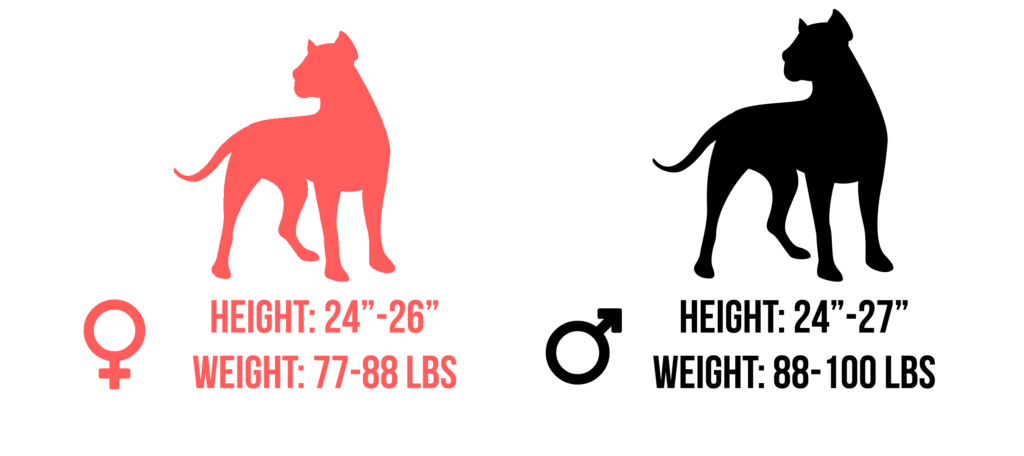 Females stand 24 to 26 inches at the shoulder. Males stand 24 to 27 inches at the shoulder. The Dogo weighs between 88 to 100 pounds.
Females stand 24 to 26 inches at the shoulder. Males stand 24 to 27 inches at the shoulder. The Dogo weighs between 88 to 100 pounds.
Appearance
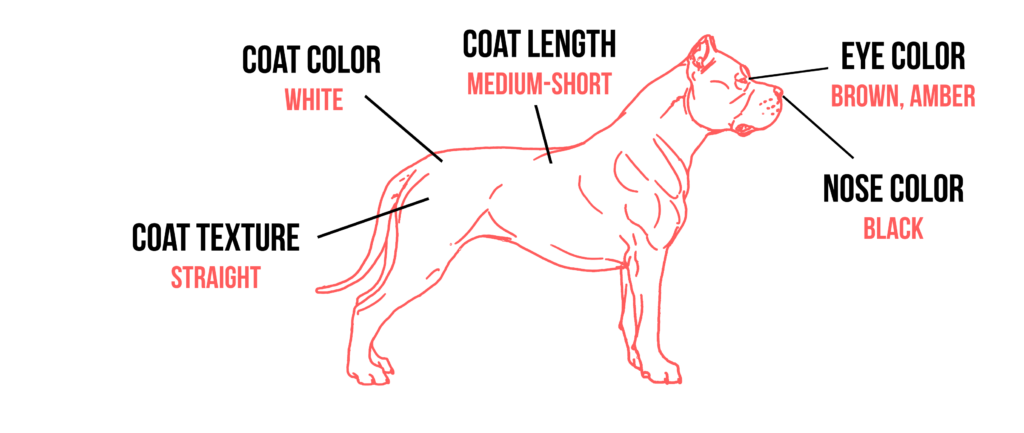 The most distinct physical feature that makes the Argentine Mastiff very recognizable is his white coat with one small black marking on his head. They have a very muscular body that is seen under his close-fitting skin. Their coat may be anywhere from 1/2 to 3/4 inch long. The thickness of their coats depends on the climate in which they live. Dogos in warmer, humid climates have a thinner coat in which you may even see their skin. Whereas Dogos in colder climates will have thicker coats and can even present a double coat. Many have their ears cropped but it is not necessary to do this. He is a very well-proportioned, strong breed with forelegs and hind legs reaching the same length.
The most distinct physical feature that makes the Argentine Mastiff very recognizable is his white coat with one small black marking on his head. They have a very muscular body that is seen under his close-fitting skin. Their coat may be anywhere from 1/2 to 3/4 inch long. The thickness of their coats depends on the climate in which they live. Dogos in warmer, humid climates have a thinner coat in which you may even see their skin. Whereas Dogos in colder climates will have thicker coats and can even present a double coat. Many have their ears cropped but it is not necessary to do this. He is a very well-proportioned, strong breed with forelegs and hind legs reaching the same length.
Behavior
Personality
The Argentine Mastiff has been described as having a dual personality. He is a gentle and loyal protector of his family and even children. On the flip side, he is an extremely capable hunter that takes on wild boar. He is fierce and gentle. The key is he should never be aggressive without a good cause. The Dogo Argentino loves to be near his family; he is a pack dog and needs to be with his family pack as much as possible. By “near his family” we mean he likes to be next to his owner, if not touching him, as much as possible. Dogos are gentle with family and children and readily welcome guests, but he will spring into action if he perceives a threat to his pack. He is an intelligent and very strong-willed breed that requires firm and consistent training from very early on. He is an extremely athletic dog that will require daily exercise and mental stimulation.
Children and Other Pets
Dogos do well with children and will protect their family pack. As with any d, g it is important to supervise interactions between children and your Dogo to teach proper rules and guidelines. It is not recommended to have other pets with a Dogo. He has a strong prey drive – small dogs and cats are not guaranteed safe around him. Some have had success raising a Dogo with other dogs and pets if they were raised together from puppyhood. Remember, he is a powerful hunting dog bred to have a strong prey drive.
Health
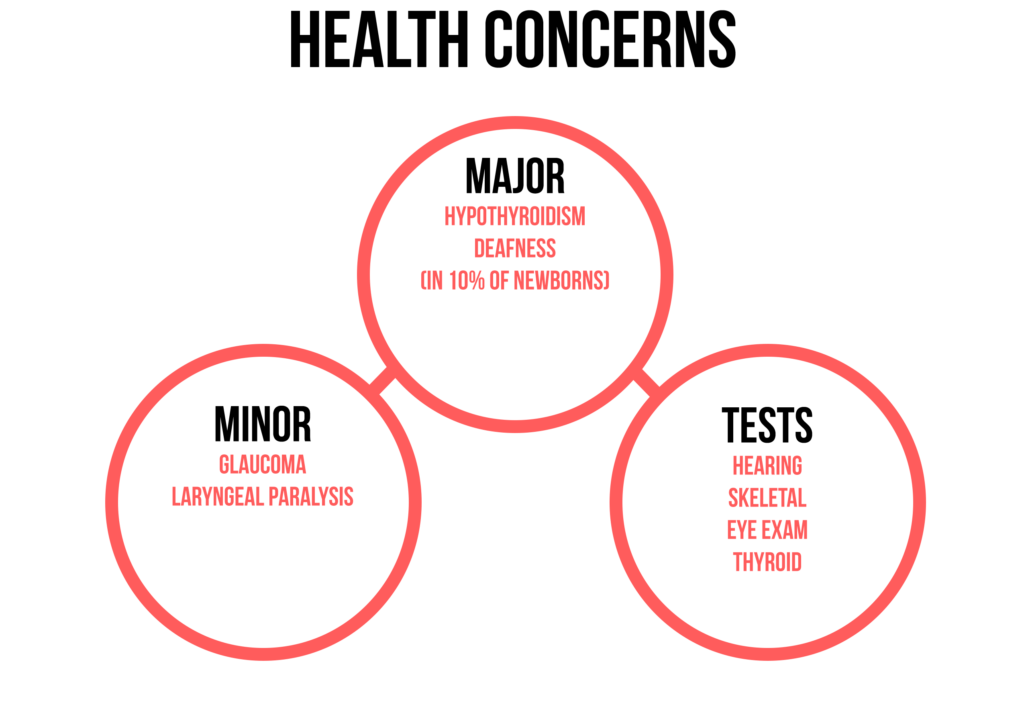 Dogo Argentinos are generally healthy dogs, but there are certain conditions that affect their breed. While your individual dog may not suffer from any of the following conditions it’s a good idea to keep them in mind. If you have access to your dog’s parental as well as their own health records, make sure to get health clearances for both of them to make sure they’ve been tested and cleared from the following conditions. Health clearances can be confirmed by checking the Orthopedic Foundation for Animals (OFA) website.
Dogo Argentinos are generally healthy dogs, but there are certain conditions that affect their breed. While your individual dog may not suffer from any of the following conditions it’s a good idea to keep them in mind. If you have access to your dog’s parental as well as their own health records, make sure to get health clearances for both of them to make sure they’ve been tested and cleared from the following conditions. Health clearances can be confirmed by checking the Orthopedic Foundation for Animals (OFA) website.
Deafness
This is a pigment related condition. Some Argentine Mastiffs have congenital deafness. It is linked to their pigment, specifically, it is linked to the gene that gives them their predominantly white coats. Many dogs adjust to living a life with partial or full deafness and can live a normal and long life.
Hypothyroidism
This condition occurs when the dog doesn’t produce enough or any of the T4 Hormone in the pituitary gland. Symptoms can be excessive weight gain, lethargic and dull mental state, increase cholesterol, and excessive shedding. This hormone assists with the metabolic process. A vet can run a blood test to verify if the Dogo does indeed have this disease. If he tests positive for it, he can be placed on a synthetic thyroid hormone treatment.
Glaucoma
Glaucoma is a condition in which pressure is placed on the eye, causing inadequate fluid drainage in the eye. If the condition becomes chronic or persists without treatment, it will eventually cause permanent damage to the optic nerve, resulting in blindness.
Laryngeal Paralysis
Laryngeal paralysis is a disorder in which the nerves that control the muscles and cartilage that open and close the larynx (voicebox) do not function properly, causing voice changes and difficulty with eating or breathing. This condition usually affects older dogs. It is treated with surgery.
Hip Dysplasia
Hip Dysplasia is a heritable condition passed down from parent to pup where the dog’s femur doesn’t perfectly fit into the pelvic socket of the hip joint, which can cause pain and lameness on one or both rear legs. However, keep in mind that the condition can exist without clinical signs, which is why it’s important to screen your dog and have them X-rayed to make sure they don’t suffer from hip dysplasia. Dogs with hip dysplasia can also develop arthritis as they age.
Skin Sensitivity
With their shorter coats, they usually do better in warmer climates but they are also more prone to sunburns in these warmer climates. If you know he will be out in the sun for a long time you can apply a doggie sunscreen from your vet to prevent sunburn and damage to his skin.
Bloating
This condition occurs in deep-chested dogs when they eat food too fast then engage in rigorous exercise right after eating. This puts pressure on their diaphragm and should be treated as an emergency. If their stomach twists they will go into shock and feel extreme pain. If not treated quickly, this is fatal. Prevention is key to this condition, make sure your dog eats two smaller meals each day and doesn’t engage in rigorous exercise immediately after eating.
Maintenance
 Care
Care
This athletic dog needs daily exercise. He would love to go running for 40 to 60 minutes every day. A hike or some agility games would also help him stay fit and keep him from finding his own outlet of choice for his pent-up energy. It is advisable to have some good chew toys at his disposal at all times to prevent him from making his own chew toys out of your couch. He needs to be trained from the day you bring him home. You need to be firm and very consistent with training him. He must be well socialized with people and other dogs to help curb his prey drive and to teach him appropriate times to act on it and when not to. He is a pack dog meaning he needs to feel part of a pack, but make sure he knows you are the alpha, otherwise he will gladly take that role.
Feeding
As with any dog, purchase high quality, nutrient dense dog food. Ask your veterinarian what food and blend would be best suited for your dog. Factors such as age, size, and activity level will make a difference on what kind of food he needs and how much. Typically, Dogo Argentinos will need 2 cups to 3 cups of high-quality dry food a day. It is recommended that this amount is divided into two separate meals, one in the morning and one at night.
Grooming
The Argentine Mastiff has a short coat that is relatively easy to care for. A bath once every other month or when he is dirty with a gentle shampoo is sufficient to keep him clean and smelling good. He will need a weekly brushing with either a bristle brush or a mitt; this will help keep the shedding under control.
A Dogo’s nails grow very fast and need to be trimmed at least twice a month. There are blood vessels in his nails so if you trim them too short it can be painful for him and he will be less likely to cooperate next time you try to trim his nails.
You will need to check his ears weekly as well and wipe them down with a cotton ball and a gentle ear cleaner from the vet to maintain healthy ears. Don’t wipe into the canal, just the top part of the ear. If you notice an odor coming from his ears take him to the vet to be checked.
Regular grooming is a great time to look at your dog and check for any cuts or odors that may need to be looked over by the vet.
Common Questions
What does Dogo Argentino mean?
Dogo Argentino is Spanish for Argentine Mastiff. Both names are used to refer to this breed, which was developed in Argentina by Antonio Nores Martinez to be a fierce hunting dog that is also loyal and gentle with his family.
Why is the Dogo Argentino illegal?
This breed is banned in Israel, Australia, Denmark, Iceland, Fiji, Ukraine, Singapore, and the United Kingdom. Since he was bred from the Cordoba fighting dog, many still have concerns about him being an aggressive dog and, therefore, ban his breed. He does have a strong prey drive and if not properly socialized he will see small dogs and cats as prey.
How long do Dogo Argentino dogs live?
The average lifespan for a Dogo Argentino is between 9 to 15 years.
Are Dogo Argentino aggressive?
With his aggressive ancestry from the Cordoba fighting dog, the Dogo can be aggressive if he is not properly socialized and trained. He should not be left with smaller dogs or cats due to his strong prey drive.
Are Dogo Argentino illegal in Australia?
The Dogo Argentino is currently banned in Australia and the UK. Many attest to his gentle and loyal nature but he still may not get along well with other strange dogs at a dog park.
Resources
Unfortunately, there are people who abuse animals and Dogo Argentinos are no exception. In fact, they are at an increased risk for abuse and may be forced into dog fights. It is illegal to hold dog fights but, unfortunately, there are underground rings that hold dog fights and Dogos are a favorite to use. If you’re interested in rescuing an Argentine Mastiff and giving them a loving home, please visit the following websites to learn how you can adopt a Dogo Argentino today:
Rescue Groups
- Dogo.com | Dogo has everything about Dogo Argentinos!
- Big Love Rescue Dogo Argentino Rescue
- DC Dogos | Dogo Argentino Rescue & Rehabilitation
- Dogo Argentino Dog Rescue / Adopt a Dogo Argentino
- Dogo Argentino Archives – Rocket Dog Rescue
Breed Organizations
- Dogo.com | Dogo has everything about Dogo Argentinos!
- Dogo Argentino – Official Site
- Dogo Argentino Breeder | Dream Dogos – Ham Lake, MN
- Dogo argentino breeder – Mt Diablo Dogos
- Cordoba Dogos
- Pure Dogo Argentino Breeder
Dogo Argentino Adults For Sale
If you’re interested in purchasing adult Dogo Argentinos, click on the links below to find what you’re looking for.
Dogo Argentino Puppies For Sale
If you’re interested in purchasing Dogo Argentino puppies, below you will find different online marketplaces that have Dogo Argentino puppies for sale.
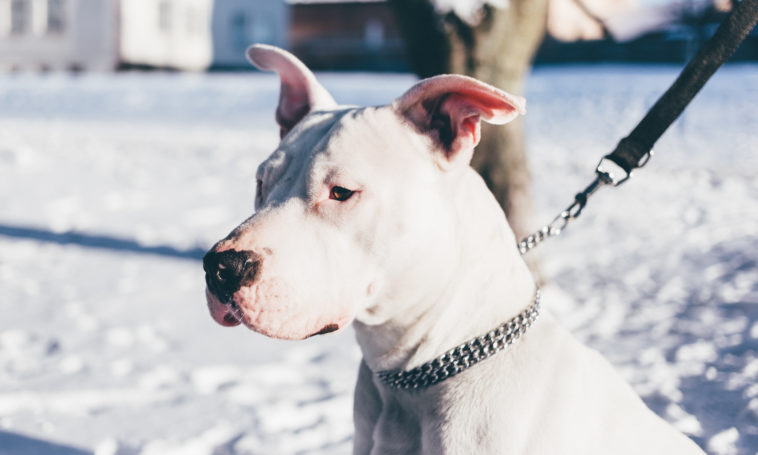
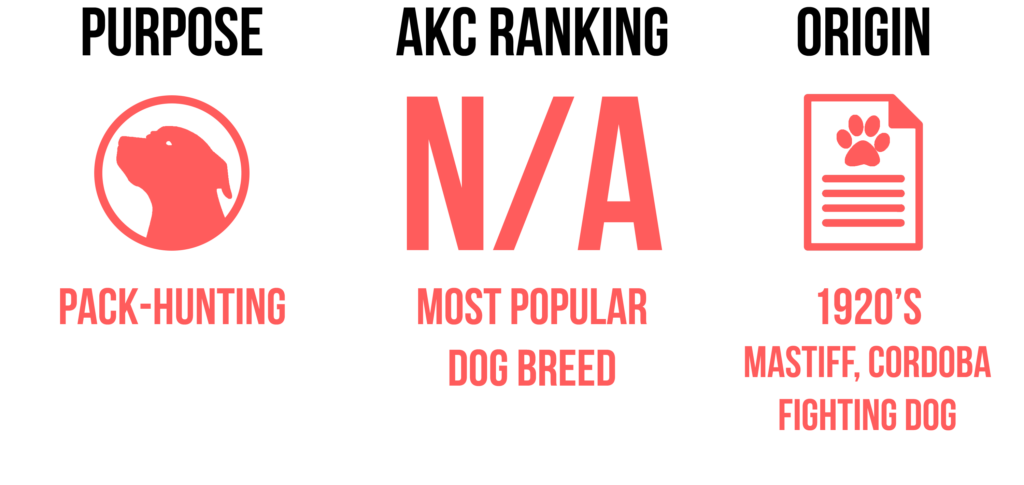 History
History Care
Care